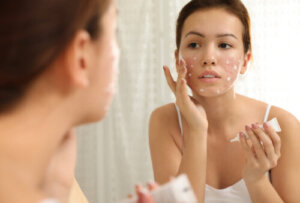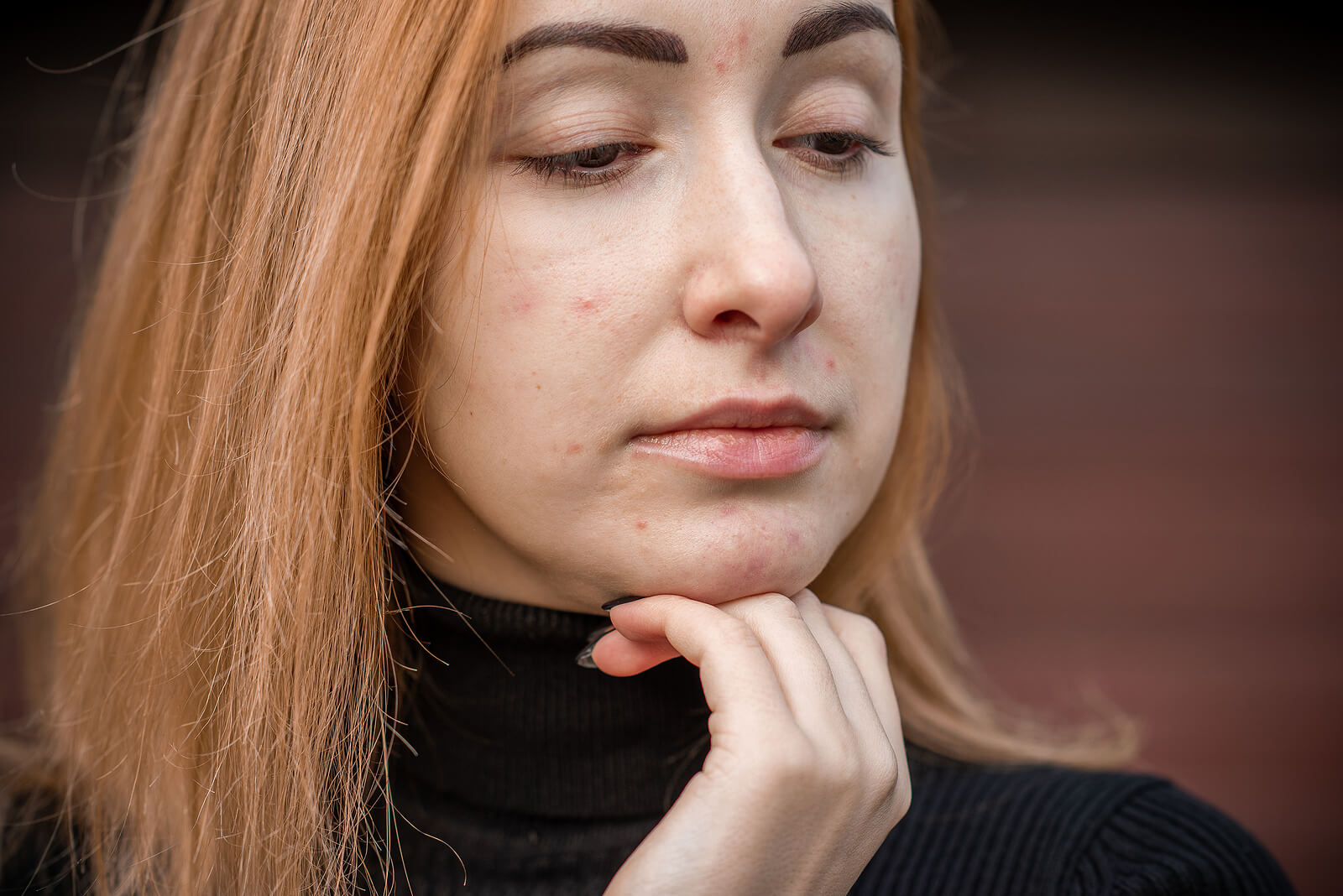The Most Common Skin Problems in Adolescents


Written and verified by the dermatologist Maria del Carmen Hernandez
The most common skin problems in adolescents are related to the functional increase of certain skin structures as a result of hormonal alterations. Adolescence is one of the most important stages of growth for both the psychological and physical development of the individual.
Most common skin problems in adolescents
The increase in circulating levels of androgens during adolescence acts on the terminal hair, apocrine sweat glands, and sebaceous glands. Stimulation or alteration of all these skin structures triggers characteristic skin surface conditions.
1. Acne vulgaris
Acne vulgaris is the most frequently observed dermatosis at this stage of development. It’s a chronic inflammatory disease characterized by the presence of the following lesions:
- Pimples
- Pustules
- Papules
- Cysts
- Scars

In adolescence, the areas of the body most affected by this type of disease are seborrheic, i.e. the shoulders, back, and face.
In addition, acne can persist into the 20s and 30s in about 64 % and 43 % of people, according to studies published in The British Journal of Dermatology. Therefore, it’s always important to use sun protection to avoid residual hyperpigmentation macules in the regions where active acne lesions are located.
You may be interested in: Acne in Teenagers: Do’s and Don’ts
2. Rosacea, one of the most common skin problems in adolescents
Rosacea is a chronic inflammatory disease and is quite commonly diagnosed. Consequently, there are four clinical subtypes that are governed by the predominant signs and symptoms:
- Erythematotelangiectatic
- Papulopustular
- Phymatous
- Ocular
According to the 2019 National Rosacea Society Expert Committee, some of the following manifestations are considered diagnostic: Fixed centrofacial erythema with a certain pattern that may intensify periodically and phymatous changes. In turn, two of the following criteria are also considered diagnostic: Redness, papules and pustules, and telangiectasias.
3. Oily skin, another common skin problem in adolescents
Oily or seborrheic skin is a skin condition predominantly seen at puberty. The skin appears shiny and oily in appearance, with enlarged pores and an increased tendency to develop acne.
The consequences of excess sebum can be linked to adverse social and psychological effects resulting from associated acne and the appearance of skin oiliness and shine.
It’s at this stage of development that a daily skincare routine should begin to be implemented to avoid the complications of sebaceous gland stimulation and development.
4. Folliculitis
Folliculitis is a common, benign skin condition in which the hair follicle becomes inflamed and infected, and a pustule forms. It sometimes occurs as a result of inflammation secondary to encysted hairs, as well as certain drugs such as lithium and cyclosporine.
The diagnosis of folliculitis is made in the physician’s office through direct observation of the lesions.
5. Viral warts
Viral warts are benign skin growths that can develop on any part of the body and in any form. They’re also very contagious growths and are commonly diagnosed at the doctor’s office. They’re harmless but can be bothersome and unattractive.
Warts are caused by the human papillomavirus (HPV), of which there are over 100 different types. This type of virus can enter the skin through a superficial lesion and develop additional growth.
6. Dandruff or seborrheic dermatitis
This type of condition develops in the seborrheic regions of the body. Therefore, there’s a greater predisposition in the upper thorax, the area behind the ears, the face, and the scalp. Some of the prevailing manifestations are the following:
- Flaking
- Pruritus
- Inflammation
- Marked erythema

The distribution of lesions on the body is symmetrical. However, this disease is neither contagious nor fatal. Treatment is focused on eliminating the signs of the disease, improving related symptoms (pruritus), and maintaining remission over time.
According to a review in Dermatology, the variety of antifungal treatments that exist are effective, flexible, and safe.
7. Atopic dermatitis
Atopic dermatitis is a chronic inflammatory skin disease that’s triggered in most cases in childhood. The condition persists from infancy to adolescence in about 40% of cases.
In addition, it manifests with palpebral dermatitis and juvenile palmar and plantar dermatitis. The therapeutic pillars for the management of atopic dermatitis in adolescents are the same as those implemented in children.
Skin problems in adolescents affect much more than skin
Skin problems in adolescents can have far-reaching consequences because much of the self-esteem of this age group is linked to their body image. It’s also advisable to start consulting a dermatologist at the puberty stage to prevent this type of condition and to start a correct skincare routine.
The most common skin problems in adolescents are related to the functional increase of certain skin structures as a result of hormonal alterations. Adolescence is one of the most important stages of growth for both the psychological and physical development of the individual.
Most common skin problems in adolescents
The increase in circulating levels of androgens during adolescence acts on the terminal hair, apocrine sweat glands, and sebaceous glands. Stimulation or alteration of all these skin structures triggers characteristic skin surface conditions.
1. Acne vulgaris
Acne vulgaris is the most frequently observed dermatosis at this stage of development. It’s a chronic inflammatory disease characterized by the presence of the following lesions:
- Pimples
- Pustules
- Papules
- Cysts
- Scars

In adolescence, the areas of the body most affected by this type of disease are seborrheic, i.e. the shoulders, back, and face.
In addition, acne can persist into the 20s and 30s in about 64 % and 43 % of people, according to studies published in The British Journal of Dermatology. Therefore, it’s always important to use sun protection to avoid residual hyperpigmentation macules in the regions where active acne lesions are located.
You may be interested in: Acne in Teenagers: Do’s and Don’ts
2. Rosacea, one of the most common skin problems in adolescents
Rosacea is a chronic inflammatory disease and is quite commonly diagnosed. Consequently, there are four clinical subtypes that are governed by the predominant signs and symptoms:
- Erythematotelangiectatic
- Papulopustular
- Phymatous
- Ocular
According to the 2019 National Rosacea Society Expert Committee, some of the following manifestations are considered diagnostic: Fixed centrofacial erythema with a certain pattern that may intensify periodically and phymatous changes. In turn, two of the following criteria are also considered diagnostic: Redness, papules and pustules, and telangiectasias.
3. Oily skin, another common skin problem in adolescents
Oily or seborrheic skin is a skin condition predominantly seen at puberty. The skin appears shiny and oily in appearance, with enlarged pores and an increased tendency to develop acne.
The consequences of excess sebum can be linked to adverse social and psychological effects resulting from associated acne and the appearance of skin oiliness and shine.
It’s at this stage of development that a daily skincare routine should begin to be implemented to avoid the complications of sebaceous gland stimulation and development.
4. Folliculitis
Folliculitis is a common, benign skin condition in which the hair follicle becomes inflamed and infected, and a pustule forms. It sometimes occurs as a result of inflammation secondary to encysted hairs, as well as certain drugs such as lithium and cyclosporine.
The diagnosis of folliculitis is made in the physician’s office through direct observation of the lesions.
5. Viral warts
Viral warts are benign skin growths that can develop on any part of the body and in any form. They’re also very contagious growths and are commonly diagnosed at the doctor’s office. They’re harmless but can be bothersome and unattractive.
Warts are caused by the human papillomavirus (HPV), of which there are over 100 different types. This type of virus can enter the skin through a superficial lesion and develop additional growth.
6. Dandruff or seborrheic dermatitis
This type of condition develops in the seborrheic regions of the body. Therefore, there’s a greater predisposition in the upper thorax, the area behind the ears, the face, and the scalp. Some of the prevailing manifestations are the following:
- Flaking
- Pruritus
- Inflammation
- Marked erythema

The distribution of lesions on the body is symmetrical. However, this disease is neither contagious nor fatal. Treatment is focused on eliminating the signs of the disease, improving related symptoms (pruritus), and maintaining remission over time.
According to a review in Dermatology, the variety of antifungal treatments that exist are effective, flexible, and safe.
7. Atopic dermatitis
Atopic dermatitis is a chronic inflammatory skin disease that’s triggered in most cases in childhood. The condition persists from infancy to adolescence in about 40% of cases.
In addition, it manifests with palpebral dermatitis and juvenile palmar and plantar dermatitis. The therapeutic pillars for the management of atopic dermatitis in adolescents are the same as those implemented in children.
Skin problems in adolescents affect much more than skin
Skin problems in adolescents can have far-reaching consequences because much of the self-esteem of this age group is linked to their body image. It’s also advisable to start consulting a dermatologist at the puberty stage to prevent this type of condition and to start a correct skincare routine.
All cited sources were thoroughly reviewed by our team to ensure their quality, reliability, currency, and validity. The bibliography of this article was considered reliable and of academic or scientific accuracy.
- Lubowe II. Adolescent skin problems. Cutis. 1976 Feb;17(2):369-74. PMID: 138533.
- Strauss JS. Skin care and incidence of skin disease in adolescence. Curr Med Res Opin. 1982;7(Suppl 2):33-45. PMID: 6213377.
- Thiboutot D, Anderson R, Cook-Bolden F, Draelos Z, Gallo RL, Granstein RD, Kang S, Macsai M, Gold LS, Tan J. Standard management options for rosacea: The 2019 update by the National Rosacea Society Expert Committee. J Am Acad Dermatol. 2020 Jun;82(6):1501-1510. doi: 10.1016/j.jaad.2020.01.077. Epub 2020 Feb 7. PMID: 32035944.
- Gupta AK, Madzia SE, Batra R. Etiology and management of Seborrheic dermatitis. Dermatology. 2004;208(2):89-93. doi: 10.1159/000076478. PMID: 15056994.
- Peters AS, Kellberger J, Vogelberg C, Dressel H, Windstetter D, Weinmayr G, Genuneit J, Nowak D, von Mutius E, Radon K. Prediction of the incidence, recurrence, and persistence of atopic dermatitis in adolescence: a prospective cohort study. J Allergy Clin Immunol. 2010 Sep;126(3):590-5.e1-3. doi: 10.1016/j.jaci.2010.06.020. Erratum in: J Allergy Clin Immunol. 2012 Apr;129(4):1176. PMID: 20816192.
- Bhate K, Williams HC. Epidemiology of acne vulgaris. Br J Dermatol. 2013 Mar;168(3):474-85. doi: 10.1111/bjd.12149. PMID: 23210645.
This text is provided for informational purposes only and does not replace consultation with a professional. If in doubt, consult your specialist.








